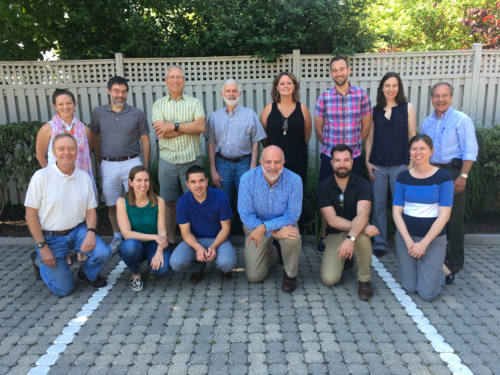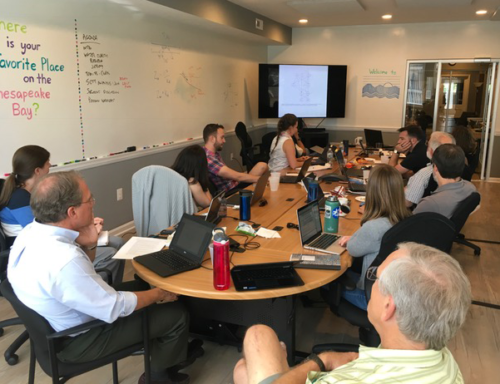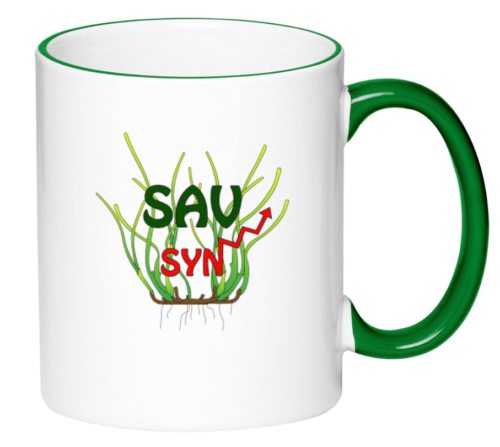Scientific synthesis paper shows Chesapeake Bay nutrient diet is working
Bill Dennison ·As part of our Submerged Aquatic Vegetation synthesis effort (SAV SYN), the paper “Long-term nutrient reductions lead to the unprecedented recovery of a temperate coastal region” was published online today in the Proceedings of the National Academy of Science (PNAS). Jon Lefcheck from the Bigelow Laboratory for Ocean Sciences, formerly at the Virginia Institute of Marine Science, was the first author, with our entire SAV SYN team as co-authors: Bob Orth, Bill Dennison, Dave Wilcox, Rebecca Murphy, Jeni Keisman, Cassie Gurbisz, Mike Hannah, Brooke Landry, Ken Moore, Chris Patrick, Jeremy Testa, Don Weller and Rich Batiuk. Previous blogs have described the SAV SYN process, identifying how to conduct scientific synthesis efforts and even posting a poem, “The Chesapeake Sentinels.” We have previously published two papers from our SAV SYN effort (Lefcheck st al., 2017; Orth et al., 2017).

The National Academy of Science featured this paper for broad dissemination. We are working with Mike Smith from GreenSmith to coordinate the dissemination among the myriad of co-author organizations. Heather Leslie, Director of the Darling Marine Center, University of Maine, wrote a thoughtful PNAS Commentary that will appear with the published paper. Heather is a champion of Ecosystem Based Management (EBM) and her commentary provides a broader perspective and discusses the implications of this study. Since the PNAS format is very brief, Heather’s Commentary is a nice companion piece.
Bob “JJ” Orth and I were asked to submit an article for The Conversation, an independent, nonprofit source of expert news and views, from the academic and research community, written for the public. We worked closely with The Conversation environment and energy editor Jennifer Weeks to publish this article titled "Cutting pollution in the Chesapeake Bay has helped underwater seagrasses rebound."


The publication date of this paper fortuitously comes just a few days after JJ Orth received the “Virginia Outstanding Scientist Award,” described in a previous blog. I am glad that JJ is getting some well-deserved recognition for his efforts in research, monitoring and management.
This paper is not the final product of the SAV SYN effort. We are working closely with Melissa Merritt, Rich Batiuk and Emily Trentacoste at the Chesapeake Bay Program to develop segment summaries that illustrate and describe the SAV condition and trends for resource managers around Chesapeake Bay. In addition, we are writing a paper about the environmental management aspects of the SAV SYN effort. But this PNAS paper will be the pinnacle of the SAV SYN effort. That is why we are glad that it is receiving broad attention.

When I have received media training by experts in the past, the adage “If it bleeds, it leads” is often quoted. They are referring to the tendency for the media to gravitate to bad news stories. And many environmental stories are indeed focused on the “doom and gloom” aspects of increasing impacts of population growth and climate change on the planet. This PNAS paper, however, which is fundamentally a good news story about management inventions that are working to improve Chesapeake Bay, is receiving broad attention. My interpretation of this unusual amount of attention to a good news story is that we have become fatigued with repeated bad environmental news. My sense is that we are hungry for inspiration like this this story that we can reverse some of the environmental degradation that has taken place. Perhaps the new media adage should be “When it succeeds, it leads.”
When describing the results of this paper to friends and colleagues, I have referred to it by a short title, based on a Richard Dawkins quote from 2013 when he was asked to defend science. I recommend watching the YouTube clip. to infer my version of the Dawkins quote, substituting “TMDL” (Total Maximum Daily Load or nutrient diet) for “Science.”

References
Lefcheck, JS, RJ Orth, WC Dennison, DJ Wilcox, RR Murphy, J Keisman, C Gurbisz, M Hannam, JB Landry, KA Moore, CJ Patrick, J Testa, DE Weller, RA Batiuk. 2018. Long-term nutrient reductions lead to the unprecedented recovery of a temperate coastal region. Proc. Natl. Acad. Sci.
Lefcheck, JS, DJ Wilcox, RR Murphy, SR Marion, RJ Orth. 2017. Multiple stressors threaten the imperiled coastal foundation species eelgrass (Zostera marina) in Chesapeake Bay, USA. Global Change Biology 23: 3474-3483.
Orth RJ, WC Dennison, JS Lefcheck, C Gurbisz, M Hannah, J Keisman, JB Landry, KA Moore, RR Murphy, CJ Patrick, J Testa, DE Weller and DJ Wilcox. 2017. Submersed aquatic vegetation in Chesapeake Bay: Sentinel species in a changing world. Bioscience 67: 698-712.
Souppouris, A. April 2, 2013. Richard Dawkins on science: ‘it works, bitches.’ Retrieved from The Verge.com.
About the author
Bill Dennison

Dr. Bill Dennison is a Professor of Marine Science and Vice President for Science Application at the University of Maryland Center for Environmental Science.
Next Post > Bob “JJ” Orth receives the Virginia Outstanding Scientist Award
Comments
-
Jason 7 years ago
Congrats, guys! I'm really looking forward to reading the article. I just need to find someone with PNAS access.
Sometimes I feel like ecology is documenting destruction and degradation, so it is refreshing to to read stories like this, especially when they include the Dawkins reference.
-
Airport Madness 3D 7 years ago
This PNAS paper, however, which is fundamentally a good news story about management inventions that are working to improve Chesapeake Bay, is receiving broad attention. My interpretation of this unusual amount of attention to a good news story is that we have become fatigued with repeated bad environmental news. My sense is that we are hungry for inspiration like this this story that we can reverse some of the environmental degradation that has taken place.i love this i like to learn more

